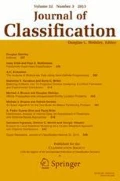Abstract
We construct a weighted Euclidean distance that approximates any distance or dissimilarity measure between individuals that is based on a rectangular cases-by-variables data matrix. In contrast to regular multidimensional scaling methods for dissimilarity data, our approach leads to biplots of individuals and variables while preserving all the good properties of dimension-reduction methods that are based on the singular-value decomposition. The main benefits are the decomposition of variance into components along principal axes, which provide the numerical diagnostics known as contributions, and the estimation of nonnegative weights for each variable. The idea is inspired by the distance functions used in correspondence analysis and in principal component analysis of standardized data, where the normalizations inherent in the distances can be considered as differential weighting of the variables. In weighted Euclidean biplots, we allow these weights to be unknown parameters, which are estimated from the data to maximize the fit to the chosen distances or dissimilarities. These weights are estimated using a majorization algorithm. Once this extra weight-estimation step is accomplished, the procedure follows the classical path in decomposing the matrix and displaying its rows and columns in biplots.
Similar content being viewed by others
References
BORG, I., and GROENEN, P.J.F. (2005), Modern Multidimensional Scaling (2nd ed.), New York: Springer.
COMMANDEUR, J.J.F., and HEISER,W.J. (1993), “Mathematical Derivations in the Proximity Scaling (PROXSCAL) of Symmetric Data Matrices”, Technical Report No. RR-93-03, Leiden, The Netherlands: Department of Data Theory, Leiden University.
DE LEEUW, J. (1977), “Applications of Convex Analysis to Multidimensional Scaling”, in Recent Developments in Statistics, eds J.R. Barra, F. Brodeau, G. Romier, and B. van Cutsem, Amsterdam: North-Holland, pp. 133–145.
DE LEEUW, J. (1988), “Convergence of the Majorization Method for Multidimensional Scaling”, Journal of Classification, 5, 163–180.
DE LEEUW, J., and HEISER, W.J. (1980), “Multidimensional Scaling with Restrictions on the Configuration”, in Multivariate Analysis, Vol. V, ed. P.R. Krishnaiah, Amsterdam: North-Holland, pp. 501–522.
DE LEEUW, J., and MAIR, P. (2009), “Multidimensional Scaling Using Majorization: SMACOF in R”, Journal of Statistical Software, 31, 1–30.
GABRIEL, K.R. (1971), “The Biplot-Graphic Display of Matrices with Applications to Principal Component Analysis”, Biometrika, 58, 453–467.
GABRIEL, K.R., and ODOROFF, C.L. (1990), “Biplots in Biomedical Research”, Statistics in Medicine, 9, 469–485.
GOWER, J.C., and HAND, D.J. (1996), Biplots, London: Chapman and Hall.
GOWER, J.C., and HARDING, S.A. (1988), “Nonlinear Biplots”, Biometrika, 75, 445–455.
GOWER, J.C., and LEGENDRE, P. (1986), “Metric and Euclidean Properties of Dissimilarity Coefficients”, Journal of Classification, 3, 5–48.
GOWER, J.C., LUBBE, S., and LE ROUX, N. (2011), Understanding Biplots, Chichester, UK: Wiley.
GREENACRE, M.J. (1984), Theory and Applications of Correspondence Analysis, London: Academic Press.
GREENACRE, M.J. (2007), Correspondence Analysis in Practice (2nd ed.), London: Chapman & Hall/CRC. Free download of the Spanish translation of this book from www.multivariatestatistics.org.
GREENACRE, M.J. (2010), Biplots in Practice, Madrid: BBVA Foundation. Free download from www.multivariatestatistics.org.
GREENACRE, M.J. (2013), “Contribution Biplots”, Journal of Computational and Graphical Statistics, 22, 107–122.
LEGENDRE, P., and LEGENDRE, L. (1998), Numerical Ecology, Amsterdam: North Holland.
R CORE TEAM (2015), “R: A Language and Environment for Statistical Computing”, R Foundation for Statistical Computing, Vienna, Austria, http://www.R-project.org.
RIOS, M., VILLAROYA,A., and OLLER, J.M. (1994), “Intrinsic Data Analysis: A Method for the Simultaneous Representation of Populations and Variables”, Research report 160, Department of Statistics, University of Barcelona.
TUCKER, L.R. (1951), “A Method for the Synthesis of Factor Analysis Studies”, Technical Report No. 984, Washington, DC: Department of the Army.
VIVES, S., and VILLAROYA, A. (1996), “La Combinació de Tècniques de Geometria Diferencial amb Anàlisi Multivariant Clàssica: Una Aplicació a la Caracterització de les Comarques Catalanes”, Qüestiió, 20, 449–482.
Author information
Authors and Affiliations
Corresponding author
Rights and permissions
About this article
Cite this article
Greenacre, M.J., Groenen, P.J.F. Weighted Euclidean Biplots. J Classif 33, 442–459 (2016). https://doi.org/10.1007/s00357-016-9213-7
Published:
Issue Date:
DOI: https://doi.org/10.1007/s00357-016-9213-7




